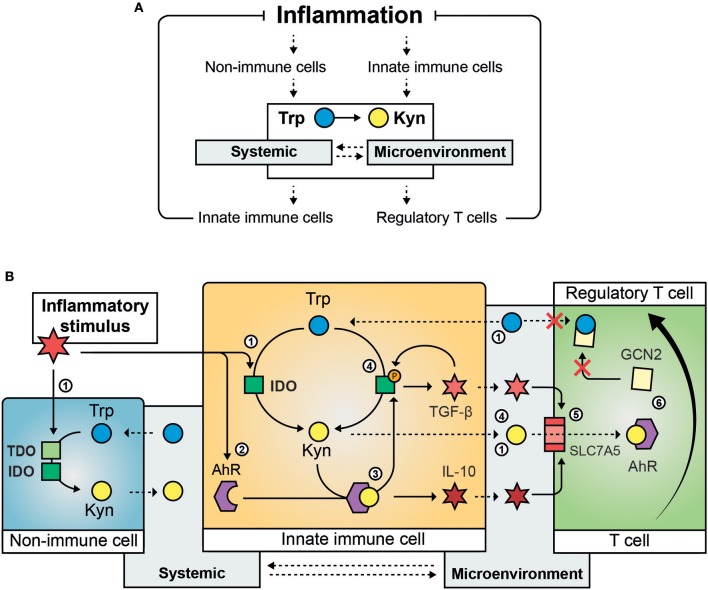Figure 1.
Mechanisms involved the regulation of inflammation by Trp metabolism. Inflammation activates Trp metabolism and causes systemic and intra- and extra-cellular changes in the Kyn/Trp ratio that suppress the inflammatory response (A). The molecular steps involved in the immunomodulatory effect of activation of Trp metabolism (B): An inflammatory stimulus activates IDO (and in specific instances TDO) in immune and non-immune cells causing reduced Trp systemic and local Trp levels and increased intra- and extracellular Kyn content (1); inflammation induces increased expression of AhR (2) that is activated by its ligand Kyn and results in the secretion of anti-inflammatory cytokines such as IL-10 (3); AhR ligand-activation causes phosphorylation of IDO and results in sustained IDO activity and the secretion of TGF-β, which is involved in a feedback loop by inducing IDO phosphorylation (4); inflammatory cytokines such as TGF-β and IL-10 induce the amino acid transporter SLC7A5 on the plasma membrane of naïve T-cells causing transport of Kyn into the T cell (5); activation of GCN2 by Trp depletion and AhR ligand-activation by Kyn cause the differentiation of naïve T cells toward regulatory T cells (6). Solid arrows indicate regulatory (transcriptional or translational) and enzymatic effects, dashed arrows indicate active or passive cross-cellular and cross-compartmental transport of Trp and Kyn. Trp, Tryptophan; Kyn, Kynurenine, IDO, indoleamine 2,3-dioxygenase; TDO, tryptophan 2,3-dioxygenase; AhR, aryl hydrocarbon receptor; TGF-β, tissue growth factor beta; IL-10, interleukin 10; SLC7A5, solute carrier family 7 member 5; GCN2, general control non-derepressable 2 stress kinase.

